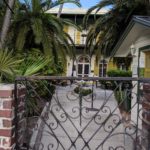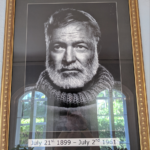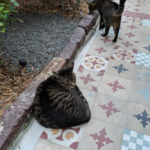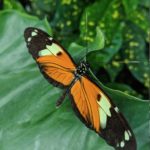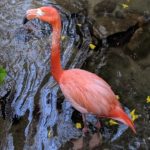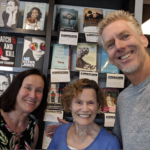 FOLLOW ME ON INSTAGRAM: @woodywoodburn
FOLLOW ME ON INSTAGRAM: @woodywoodburn
*
Part 2: Hemingway’s
“Last Red Cent”
The stairway to heaven has 19 steps.
Before climbing the outdoor flight leading to Ernest Hemingway’s second-floor writing studio in the backyard, spitting distance away I toured the main house at 907 Whitehead Street in Key West’s Old Town. It is a mansion masterpiece.
The Spanish antiques and African artwork throughout, much collected by Hemingway himself, are stunning. However, I was more captivated by the wordsmith’s seven typewriters – three Underwood models; one Remington portable; two Corona machines, one black and the other forest green; and one Royal – displayed in various rooms.

Hanging out with Hemingway in his Key West home.
The black Royal portable, Hemingway’s favorite, naturally resides in his next-door upstairs studio. The spacious room has robin-egg blue walls and red terra cotta tile floor. Sun pours through ample windows, one of which affords a view of the Atlantic Ocean.
In addition to bookcases fully filled, the décor features taxidermic hunting trophies plus a mounted fish – albeit greatly smaller than Santiago’s great marlin in “The Old Man and the Sea.”
The showpiece of the room, however, is a modest round table the master used as a desk paired with a lone wooden chair. Upon the well-worn tabletop sits Hemingway’s prized typewriter as well as a notebook with a pen resting on its open pages.
When I came through, an orange six-toed cat was also resting on the table-turned-desk. One could imagine the tabby was waiting for its master to return because a sheet of typing paper was in the Royal, as if Papa had just stepped out for a moment.
“There is nothing to writing,” Hemingway famously said. “All you do is sit down at a typewriter and bleed.”
Hemingway bled profusely in this den from 1931 to 1939, writing nine books. The prolific period began with “Death in the Afternoon”, included “The Green Hills of Africa” and “For Whom the Bells Toll”, and ended with “Under Kilimanjaro.” His process was to rise at dawn and hunch over his Royal until early afternoon, always quitting while still in the flow so it would be easier start anew the following morning.
The magic one feels standing before the Mona Lisa or the marble David, I experienced here. Oh, how I would have loved to give the Pulitzer Prize winner’s antique Royal a whirl for a sentence or three!
Too, I would have liked to dive into the magnificent swimming pool some two dozen strides from the writing studio and directly below the master bedroom in the main house. Dug into solid coral ground, it took two years to complete and was the only swimming pool within 100 miles.
Measuring 60 feet by 24 feet and 10 feet deep at the south end, half that at the opposite point on the compass, the rectangular pool cost a staggering $20,000 in 1938. Understand, less than a decade earlier the entire home and acre of land was purchased for $8,000.
Hemingway was exasperated at the pool’s final cost and at his second wife who oversaw its construction while he was away as a correspondent for the Spanish Civil War. Upon his return, he is said to have flung down a penny and complained: “Pauline, you’ve spent all but my last red cent, so you might as well have that!”
Offered as evidence that the story is true and not apocryphal, Pauline had a penny embedded heads-up in the cement on the shallow-end deck. Superstitiously, I left a shiny penny behind on top of that famous red cent.
Soon thereafter, I left a few dollars behind in the gift shop for a leather bookmark with the image of a lucky six-toed cat.
* * *
Woody Woodburn writes a weekly column for The Ventura County Star and can be contacted at WoodyWriter@gmail.com. Follow him on Twitter and Instagram at @woodywoodburn. His books are available at www.WoodyWoodburn.com.
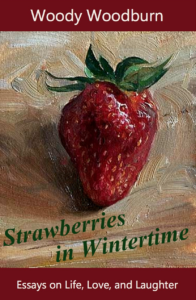
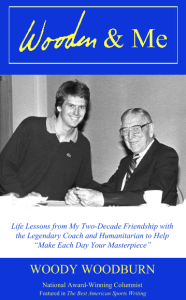 Check out my memoir WOODEN & ME: Life Lessons from My Two-Decade Friendship with the Legendary Coach and Humanitarian to Help “Make Each Day Your Masterpiece” and my essay collection “Strawberries in Wintertime: Essays on Life, Love, and Laughter” …
Check out my memoir WOODEN & ME: Life Lessons from My Two-Decade Friendship with the Legendary Coach and Humanitarian to Help “Make Each Day Your Masterpiece” and my essay collection “Strawberries in Wintertime: Essays on Life, Love, and Laughter” …
- Personalized signed copies are available at WoodyWoodburn.com

